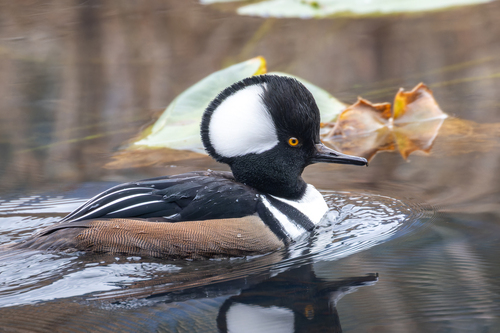
Hooded Merganser
The Hooded Merganser (Lophodytes cucullatus) is a striking diving duck renowned for its distinctive, fan-shaped crest, which both males and females can raise and lower. This small merganser is a North American species, playing an important role in its wetland ecosystems as both predator and prey. It is not typically targeted by hunters, and its populations are generally stable. Culturally, the Hooded Merganser is often admired by birdwatchers for its beauty and is sometimes featured in wildlife art and photography.
40-49 cm
Length
60-70 cm
Wingspan
Least Concern
Conservation Status
Distribution
The Hooded Merganser is found primarily in North America. It breeds across Canada and the northern United States, extending south in the eastern US to the Gulf Coast. Wintering grounds include the southern United States and parts of Mexico. Some populations are resident year-round, while others undertake short- to medium-distance migrations.
Lifespan
The average lifespan in the wild is 6-7 years, but individuals can live up to 14 years.
Hooded Merganser's Habitat
Habitat Types
Forested wetlands, Rivers, Lakes, Ponds, Beaver ponds
Climate Zones
Temperate, Boreal
Adaptations
Hooded Mergansers are adapted to diving for food, with serrated bills to help them grasp slippery prey like fish and crustaceans. They prefer habitats with clear water for visual hunting and require forested areas with suitable nesting cavities.
Variations
No recognized subspecies exist. However, there may be slight regional variations in size or plumage, but these are not formally classified.
Appearance
Breeding Plumage
Breeding males have a striking black-and-white crest, black back, chestnut flanks, and a white breast. Females and non-breeding males have a more subdued, grayish-brown plumage with a reddish-brown crest.
Seasonal Feather Changes
Males undergo an eclipse plumage after breeding, resembling the female's appearance. They regain their breeding plumage in the fall.
Sex Based Plumage Differences
Significant sexual dimorphism exists, with males having a much more elaborate and colorful plumage during the breeding season.
Notable Features
Large, fan-shaped crest that can be raised or lowered., Serrated bill for catching fish., Striking black and white pattern on male's head.
Diet and Feeding
Primary Foods
Small fish, Crustaceans, Aquatic insects, Amphibians, Mollusks
Foraging Behavior
Hooded Mergansers are diving ducks, typically foraging in clear, shallow water. They use their keen eyesight to locate prey underwater and their serrated bills to capture and hold it.
Specializations
Their serrated bill is a key specialization for catching and holding slippery prey like fish. Their eyes are adapted for underwater vision.
Seasonal Diet Variations
Diet can vary slightly depending on prey availability. During the breeding season, they may consume more insects, while fish may be more important in winter.
Behavior
Social Structure
Generally solitary or found in pairs during the breeding season. They can form small flocks during migration and winter.
Communication
Vocalizations (grunts, croaks, chatters), Visual displays (crest-raising, head-shaking), Courtship rituals
Migration
Many populations are migratory, moving from northern breeding grounds to southern wintering areas. Migration is typically triggered by freezing water conditions.
Territorial or Group Behaviors
Males are territorial during the breeding season, defending their nesting site and mate. Outside of breeding, they are less territorial and may form small groups.
Conservation
Threats
Habitat loss (deforestation, wetland drainage), Water pollution, Lead poisoning (from ingested lead shot), Collision with man-made structures
Protection Programs
Wetland conservation and restoration efforts, Regulations on lead shot use in some areas, Monitoring of populations through bird surveys
Local National Laws
Protected under the Migratory Bird Treaty Act in the United States and similar legislation in Canada and Mexico.
Population Trend
Stable
Population Estimates
The global population is estimated to be around 440,000 - 590,000 individuals.
Interesting Facts
They are one of the few duck species that primarily nest in tree cavities.
This makes them dependent on mature forests near water.
Ducklings jump from the nest cavity to the ground or water, often from heights of up to 50 feet, shortly after hatching.
They are unharmed by the fall due to their light weight and downy feathers.
They can stay underwater for up to two minutes.
This allows them to forage effectively for fish and other aquatic prey.
The name 'merganser' comes from the Latin words 'mergus' (a diving bird) and 'anser' (goose).
Though they are diving birds like the meaning behind their name, they are ducks, not geese.
Faqs about Hooded Merganser
What is the difference between a male and female Hooded Merganser?
Males have a striking black and white crest, black back, and chestnut flanks, while females are mostly grayish-brown with a reddish-brown crest.
Where can I see a Hooded Merganser?
Look for them in forested wetlands, lakes, and rivers, particularly in areas with clear water and nearby trees for nesting.
Are Hooded Mergansers hunted?
They are not a primary target for hunters, but some are taken incidentally during duck hunting seasons.
Do Hooded Mergansers mate for life?
They are typically seasonally monogamous, forming pair bonds that last for a single breeding season. New pairs form each year.
Copyright @ Nature Style Limited. All Rights Reserved.
 English
English